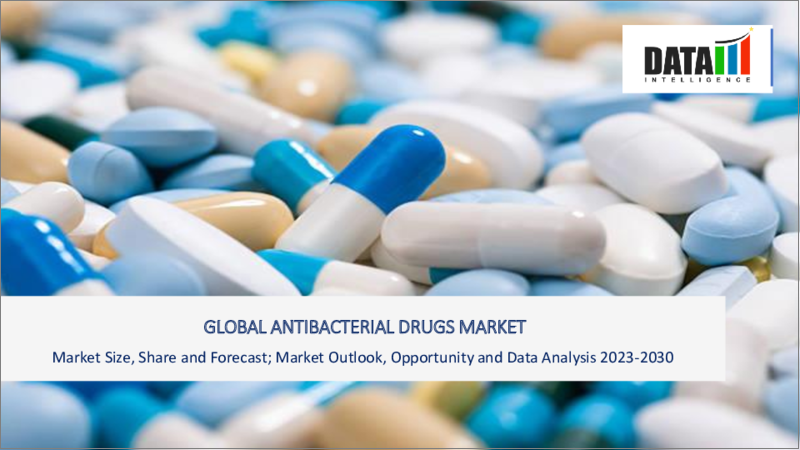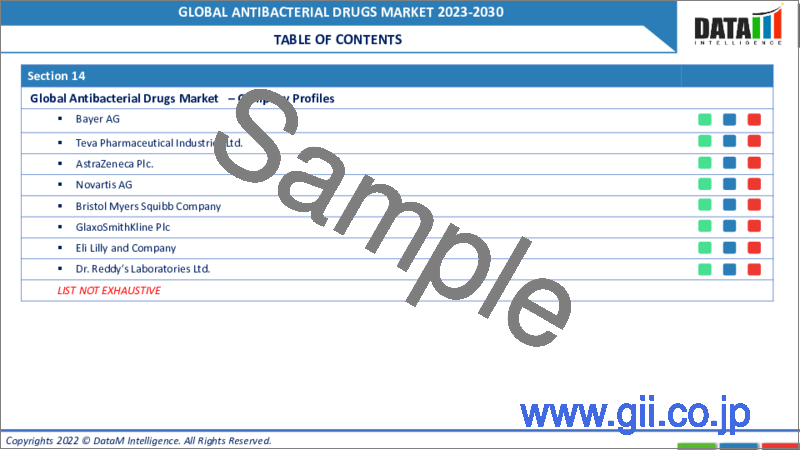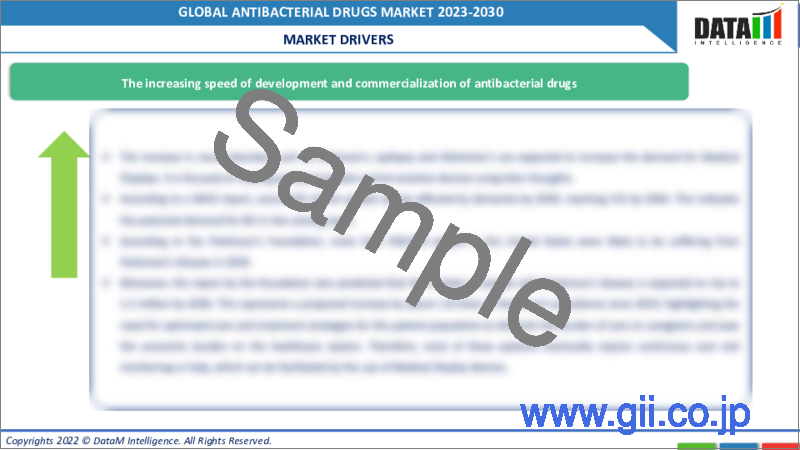|
|
市場調査レポート
商品コード
1268929
抗菌薬の世界市場-2023-2030Global Antibacterial Drugs Market - 2023-2030 |
||||||
|
● お客様のご希望に応じて、既存データの加工や未掲載情報(例:国別セグメント)の追加などの対応が可能です。 詳細はお問い合わせください。 |
|||||||
| 抗菌薬の世界市場-2023-2030 |
|
出版日: 2023年05月02日
発行: DataM Intelligence
ページ情報: 英文 195 Pages
納期: 約2営業日
|
- 全表示
- 概要
- 目次
市場概要
世界の抗菌薬市場は、2022年に438億5,740万米ドルに達し、2030年には633億2,680万米ドルに達することで有利な成長が予測されます。世界の抗菌薬市場は、予測期間中(2023-2030年)に4.8%のCAGRを示すと予測されています。主要な地域プレーヤーは、売上を増やすために新製品の発売を重視しています。
例えば、2023年2月、日本の製薬会社である塩野義製薬は、デンマークで抗菌薬を発売しました。FETCROJA(セフィデロコル)は、治療法の選択肢が限られている成人(18歳以上)の好気性グラム陰性菌による感染症の治療薬として、デンマークで発売されました。このデンマークでの発売は、世界の抗菌薬市場において抗生物質耐性感染症が増加傾向にある欧州において、cefiderocolへのアクセスを急速に拡大する重要な一歩となります。
抗菌薬は、細菌やカビに由来し、細胞壁の生成を阻害し、細胞膜の透過性を高め、タンパク質合成や核酸代謝などの代謝過程を阻害することで効果を発揮します。抗菌薬は、フェノキシメチルペニシリンやペニシリンVなどがあり、細菌に関連する疾患の治療に使用されます。しかし、風邪やインフルエンザ、ほとんどの咳などのウイルス感染症は治療できません。
さらに、抗菌薬の前臨床開発パイプラインの増加、FDA承認の増加、主要市場プレイヤーによるパートナーシップの増加が、予測期間中の抗菌薬市場の成長を促進する要因として期待されています。
市場力学
抗菌薬耐性(AMR)に対応するための研究開発機関による共同研究の増加が、市場成長を促進する
Global Antibiotic Research and Development Partnership(GARDP)によると、抗生物質耐性は、細菌が時間の経過とともに変化し、治療に反応しなくなることで発症するとされています。毎年、何百万人もの人々が抗生物質耐性に苦しみ、130万人近くが亡くなっています。さらに、世界保健機関(WHO)は、抗生物質耐性を世界の健康上の脅威のトップ10の1つとしており、薬剤耐性感染症のパンデミックとして世界的に広がっています。
2023年3月9日、世界抗生物質研究開発パートナーシップ(GARDP)とリバプール大学は、公衆衛生のために抗菌剤耐性(AMR)に対処するための新しいプロジェクトで協力する覚書に署名しました。
同様に、2023年4月3日、世界保健機関とGARDPは、多剤耐性菌感染症の治療に使用される抗生物質「セフィデロクル」の開発について、メーカーに申請を呼びかけました。WHOのPQP(Prequalification of Medicines Programme)が、複数の細菌感染症を業務に含めるのは今回が初めてとなります。PQPは、多剤耐性菌治療を手頃な価格で利用できるようにするためのイニシアチブを支援するために、招待状を出しています。
新しい抗生物質の開発における課題が、抗菌薬市場の成長を妨げています
研究開発には時間とコストがかかり、失敗も多いため、新しい抗生物質を発見・創出することは困難です。例えば、新しい抗生物質の開発には10~15年の歳月と10億米ドル以上の費用がかかると言われています。さらに、治験の最終段階と最初の製品発売後が、新薬の研究開発費全体の80%を占めることもあり、抗菌薬市場の成長を阻害しています。
COVID-19の影響度分析
COVID-19のパンデミックは、抗菌薬市場に大きな影響を及ぼしています。病院や診療所では、緊急でない診療の予約が遅れたり延期されたりして、適切な治療を受ける患者の数が減少しました。さらに、細菌感染症の患者は、COVID-19の感染を恐れて、医療機関を受診することを躊躇している可能性があります。その結果、抗菌薬市場の収益は減少しましたが、COVIDには依然として使用されており、予測期間中の市場の安定した成長を保証しています。
ロシア・ウクライナ紛争分析
ウクライナのヘルスケアシステムは、ロシアの侵攻により、多くの施設が破壊され、熟練した医療スタッフの不足により利用できる施設が限られているなどの問題を抱えています。国の統計によると、侵略者はウクライナ東部で505の薬局に損害を与え、そのうち47が破壊され、ウクライナ政府や他の国から提供される人道支援を妨害しています。
その上、慢性疾患を持つ患者が大量に薬を購入したため、薬局の販売量はロシア侵攻から11日間で倍増しました。よく購入された医薬品の上位は、抗炎症・抗リウマチ剤、C09、鎮痛剤、精神安定剤、糖尿病治療薬、全身用抗菌剤でした。
ウクライナの医薬品市場は、2022年3月以降、2021年の同時期に比べ、3月は11%、4月は32%、5月と6月は24%と大きく売上が減少しています。減少の原因は、移住、職業、医療人道支援、国民の所得低下です。1月は31%、2月は45%と、戦前に市場が大きく成長した直後から減少傾向が始まっています。
目次
第1章 調査手法とスコープ
- 調査手法
- 調査目的および調査範囲について
第2章 定義と概要
第3章 エグゼクティブサマリー
- アクションタイプ別スニペット
- 薬物タイプ別スニペット
- 投与経路別スニペット
- 薬理作用別スニペット
- 流通チャネル別スニペット
- 地域別スニペット
第4章 市場力学
- 影響要因
- 促進要因
- 抗菌薬耐性(AMR)に対応するための研究開発機関別共同研究の増加が、市場成長を促進する
- 抑制要因
- 新しい抗生物質の開発における課題が、抗菌薬市場の成長を阻害している
- 機会
- 臨床試験数の増加
- 影響度分析
- 促進要因
第5章 産業分析
- ポーターのファイブフォース分析
- サプライチェーン分析
- アンメットニーズ
- 規制分析
第6章 COVID-19の分析
- COVID-19の解析について
- COVID-19シナリオ前
- 現在のCOVID-19シナリオ
- ポストCOVID-19または将来シナリオ
- COVID-19 の中での価格ダイナミクス
- 需給スペクトル
- パンデミック時の市場に関連する政府の取り組み
- メーカーの戦略的な取り組み
- 結論
第7章 ロシア・ウクライナ戦争分析
第8章 アクションタイプ別
- 静菌
- 殺菌
第9章 薬剤タイプ別
- β-ラクタム系
- アミノグリコシド
- マクロライド
- キノロン
- テトラサイクリン系
- スルホンアミド
- その他
第10章 投与経路別
- オーラル
- 非経口
- その他
第11章 薬物メカニズム別
- 細胞壁合成の阻害
- タンパク質合成の阻害
- 細胞膜の変化
- 核酸合成阻害作用
- 代謝拮抗作用
第12章 流通チャネル別
- 小売薬局
- 病院内薬局
- オンライン薬局
第13章 地域別
- 北米
- 米国
- カナダ
- メキシコ
- 欧州
- ドイツ
- 英国
- フランス
- イタリア
- スペイン
- その他欧州
- 南米
- ブラジル
- アルゼンチン
- その他南米地域
- アジア太平洋地域
- 中国
- インド
- 日本
- オーストラリア
- その他アジア太平洋地域
- 中東・アフリカ地域
第14章 競合情勢について
- 競合シナリオ
- 市場シェア分析
- M&A分析
第15章 企業プロファイル
- Pfizer Inc.
- 会社概要
- 製品ポートフォリオと説明
- 財務概要
- 主な展開
- Sanofi S.A.
- Bayer AG
- Teva Pharmaceutical Industries Ltd.
- Dr. Reddy's Laboratories Ltd.
- Novartis AG
- Bristol Myers Squibb Company
- GlaxoSmithKline Plc
- Eli Lilly and Company
- Shionogi & Co., Ltd.
第16章 付録
Market Overview
The global antibacterial drugs market reached US$ 43,857.4 million in 2022 and is projected to witness lucrative growth by reaching up to US$ 63,326.8 million by 2030. The global antibacterial drugs market is expected to exhibit a CAGR of 4.8% during the forecast period (2023-2030). Major regional players, such as Shionogi & Co., Ltd., Savior Lifetec, Pfizer Inc., and Spero Therapeutics, among others are focusing the new product launches to increase their sales.
For instance, in February 2023, Japanese pharma firm Shionogi launched an anti-bacterial drug in Denmark. FETCROJA (cefiderocol) is now available in Denmark for treating infections due to aerobic Gram-negative bacteria in adults (18 years or older) with limited treatment options. This launch in Denmark is an important step in rapidly expanding access to cefiderocol across Europe, where we see an increasing trend in the number of antibiotic-resistant infections enhancing the global antibacterial drugs market.
Antibacterial drugs are derived from bacteria or molds and work by inhibiting cell wall production, increasing cell membrane permeability, and interfering with protein synthesis, nucleic acid metabolism, and other metabolic processes. Antibacterial drugs, which include phenoxymethylpenicillin and penicillin V, are used to treat bacteria-related disorders. However, it doesn't treat viral infections such as colds, flu, and most coughs.
Furthermore, rising preclinical development pipelines in antibacterial agents, increasing FDA approvals, and increasing partnerships by key market players are the factors that are expected to drive the antibacterial drugs market growth over the forecast period.
Market Dynamics
The increasing collaborations by R&D organizations to address antimicrobial resistance (AMR) drives market growth
According to the Global Antibiotic Research and Development Partnership (GARDP), antibiotic resistance develops when bacteria change over time and no longer respond to treatment. Every year, millions of people suffer from antibiotic resistance, and almost 1.3 million people die. Moreover, the World Health Organisation has identified antibiotic resistance as one of the top ten global health threats and it is spreading globally as a pandemic of drug-resistant infections.
On March 9, 2023, the Global Antibiotic Research and Development Partnership (GARDP) and the University of Liverpool signed a Memorandum of Understanding (MOU) to collaborate on new projects to address antimicrobial resistance (AMR) for the benefit of public health.
Similarly, on April 3, 2023, the World Health Organization and GARDP invited manufacturers to apply to develop cefiderocol, an antibiotic used to treat multidrug-resistant bacterial infections. This is the first time the WHO Prequalification of Medicines Programme (PQP) has included multiple bacterial infections in its work. The PQP has extended an invitation to help initiatives promote the affordability and availability of multidrug-resistant bacteria therapy.
Challenges in developing new antibiotics are hampering the growth of the antibacterial drugs market
Discovering and creating new antibiotics is difficult since the research and development process is time-consuming, costly, and frequently fails. For instance, a new antibiotic can take 10-15 years and more than $1 billion to be developed. Moreover, the final phase of trials and after an initial product launch can account for 80% of the total R&D spend on a new drug, thereby inhibiting the antibacterial drug market growth.
COVID-19 Impact Analysis
The COVID-19 pandemic has had a significant impact on the antibacterial drug market. Hospitals and clinics have delayed or postponed non-emergency appointments, leading to fewer patients receiving proper treatment. Additionally, patients with bacterial infections may have been reluctant to seek medical attention due to fears of contracting COVID-19. As a result, revenue in the antibacterial drugs market has decreased, but they are still used for COVID, ensuring the market's steady growth during the forecast period.
Russia-Ukraine Conflict Analysis
The Ukrainian healthcare system is facing issues due to the Russian invasion, with many facilities destroyed and limited availability due to a shortage of skilled medical staff. According to the national statistics, the invaders have damaged 505 pharmacies in Eastern Ukraine, 47 of which were destroyed, and are blocking humanitarian aid provided by the Ukrainian government or other countries.
Besides, the volume of pharmacy sales doubled in the first 11 days of the Russian invasion due to large amounts of medications purchased by patients with chronic conditions. The top most often bought medicines were antiinflammatory and antirheumatic products, C09, analgesics, psychoanaleptics, diabetes drugs, and antibacterials for systemic use.
The Ukrainian pharmaceutical market has seen a significant drop in sales since March 2022, with 11% in March, 32% in April, and 24% in May and June compared to the same period of 2021. The decline is due to migration, occupation, medical humanitarian aid, and a drop in the income of the population. The downward trend began just after a substantial growth of the market before the war, with 31% in January and 45% in February.
Segment Analysis
The global antibacterial drugs market is segmented based on the action type, drug type, route of administration, drug mechanism, distribution channel, and region.
The oral segment is expected to hold a dominant position in the market over the forecast period.
The oral segment accounted for the highest market stake accounting for approximately 48.8% of the antibacterial drugs market in 2022. Oral administration is the most practical and economical way to administer antibiotics, but it can be unpredictable in certain people. Oral therapy is used when it is tolerable and provides a sufficient therapeutic effect, while parenteral therapy is reserved for patients with difficulty having oral medicines or needing higher antimicrobial activity.
Moreover, oral administration over intravenous administration is beneficial due to the absence of thrombophlebitis and cannula-related infections, reduced drug costs, and decreased hidden costs. It can also make early hospital discharge or discharge straight from the emergency room possible.
For instance, oral antibiotics can treat uncomplicated UTIs, but readmission rates should not be lower than intravenous antibiotics. The bioavailability of oral antibiotics is an important factor in determining the effectiveness of intravenous drugs, as they may be substituted depending on the condition and drug penetration. Antibiotics such as Clindamycin, Fluconazole, Metronidazole, Sulfamethoxazole/trimethoprim, and Doxycline are commonly administered orally. Therefore, this segment will boost the global antibacterial drugs market growth over the forecast period.
Geographical Analysis
The merger and acquisition strategy by the key market players is to dominate the North American region.
North America is expected to dominate the worldwide antibacterial drugs market, accounting for around 1/3rd of this market, with the U.S. being the major contributor. For instance, in May 2022, Entasis Therapeutics, an antibiotic biotech, was acquired by Innoviva. On a fully diluted basis, the transaction values Entasis' stock at $113 million. Entasis' flagship medicine, SUL-DUR, outperformed an existing treatment in phase 3 clinical trial last year and is scheduled for FDA approval in mid-2022. SUL-DUR is a targeted antibiotic.
Competitive Landscape
The major global players in the market include: Pfizer Inc., Sanofi S.A., Bayer AG, Teva Pharmaceutical Industries Ltd., Dr. Reddy's Laboratories Ltd., Shionogi & Co., Ltd., Eli Lilly and Company, GlaxoSmithKline Plc, Bristol Myers Squibb Company, and Novartis AG, among others.
Why Purchase the Report?
- To visualize the global antibacterial drugs market segmentation based on the action type, drug type, route of administration, drug mechanism, distribution channel, and region, as well as understand key commercial assets and players.
- Identify commercial opportunities by analyzing trends and co-development.
- Excel data sheet with numerous data points of antibacterial drugs market-level with all segments.
- PDF report consists of a comprehensive analysis after exhaustive qualitative interviews and an in-depth study.
- Product mapping available as Excel consisting of key products of all the major players.
The global antibacterial drugs market report would provide approximately 77 tables, 76 figures, and 195 Pages.
Target Audience 2023
- Manufacturers/ Buyers
- Industry Investors/Investment Bankers
- Research Professionals
- Emerging Companies
Table of Contents
1. Methodology and Scope
- 1.1. Research Methodology
- 1.2. Research Objective and Scope of the Report
2. Definition and Overview
3. Executive Summary
- 3.1. Snippet by Action Type
- 3.2. Snippet by Drug Type
- 3.3. Snippet by Route of Administration
- 3.4. Snippet by Drug Mechanism
- 3.5. Snippet by Distribution Channel
- 3.6. Snippet by Region
4. Dynamics
- 4.1. Impacting Factors
- 4.1.1. Drivers
- 4.1.1.1. The increasing collaborations by R&D organizations to address antimicrobial resistance (AMR) drives market growth
- 4.1.2. Restraints
- 4.1.2.1. Challenges in developing new antibiotics are hampering the growth of the antibacterial drugs market
- 4.1.3. Opportunity
- 4.1.3.1. Increasing number of clinical trials
- 4.1.4. Impact Analysis
- 4.1.1. Drivers
5. Industry Analysis
- 5.1. Porter's Five Forces Analysis
- 5.2. Supply Chain Analysis
- 5.3. Unmet Needs
- 5.4. Regulatory Analysis
6. COVID-19 Analysis
- 6.1. Analysis of COVID-19
- 6.1.1. Before COVID-19 Scenario
- 6.1.2. Present COVID-19 Scenario
- 6.1.3. Post COVID-19 or Future Scenario
- 6.2. Pricing Dynamics Amid COVID-19
- 6.3. Demand-Supply Spectrum
- 6.4. Government Initiatives Related to the Market During the Pandemic
- 6.5. Manufacturers' Strategic Initiatives
- 6.6. Conclusion
7. Russia-Ukraine War Analysis
8. By Action Type
- 8.1. Introduction
- 8.1.1. Market Size Analysis and Y-o-Y Growth Analysis (%), By Action Type
- 8.1.2. Market Attractiveness Index, By Action Type
- 8.2. Bacteriostatic*
- 8.2.1. Introduction
- 8.2.2. Market Size Analysis and Y-o-Y Growth Analysis (%)
- 8.3. Bactericidal
9. By Drug Type
- 9.1. Introduction
- 9.1.1. Market Size Analysis and Y-o-Y Growth Analysis (%), By Drug Type
- 9.1.2. Market Attractiveness Index, By Drug Type
- 9.2. Beta-lactams*
- 9.2.1. Introduction
- 9.2.2. Market Size Analysis and Y-o-Y Growth Analysis (%)
- 9.3. Aminoglycosides
- 9.4. Macrolides
- 9.5. Quinolones
- 9.6. Tetracyclines
- 9.7. Sulfonamide
- 9.8. Others
10. By Route of Administration
- 10.1. Introduction
- 10.1.1. Market Size Analysis and Y-o-Y Growth Analysis (%), By Route of Administration
- 10.1.2. Market Attractiveness Index, By Route of Administration
- 10.2. Oral*
- 10.2.1. Introduction
- 10.2.2. Market Size Analysis and Y-o-Y Growth Analysis (%)
- 10.3. Parenteral
- 10.4. Others
11. By Drug Mechanism
- 11.1. Introduction
- 11.1.1. Market Size Analysis and Y-o-Y Growth Analysis (%), By Drug Mechanism
- 11.1.2. Market Attractiveness Index, By Drug Mechanism
- 11.2. Inhibition of Cell Wall Synthesis*
- 11.2.1. Introduction
- 11.2.2. Market Size Analysis and Y-o-Y Growth Analysis (%)
- 11.3. Inhibition of Protein Synthesis
- 11.4. Alteration of Cell Membranes
- 11.5. Inhibition of Nucleic Acid Synthesis
- 11.6. Antimetabolite Activity
12. By Distribution Channel
- 12.1. Introduction
- 12.1.1. Market Size Analysis and Y-o-Y Growth Analysis (%), By End User
- 12.1.2. Market Attractiveness Index, By End User
- 12.2. Retail Pharmacies*
- 12.2.1. Introduction
- 12.2.2. Market Size Analysis and Y-o-Y Growth Analysis (%)
- 12.3. Hospital Pharmacies
- 12.4. Online Pharmacies
13. By Region
- 13.1. Introduction
- 13.1.1. Market Size Analysis and Y-o-Y Growth Analysis (%), By Region
- 13.1.2. Market Attractiveness Index, By Region
- 13.2. North America
- 13.2.1. Introduction
- 13.2.2. Key Region-Specific Dynamics
- 13.2.3. Market Size Analysis and Y-o-Y Growth Analysis (%), By Action Type
- 13.2.4. Market Size Analysis and Y-o-Y Growth Analysis (%), By Drug Type
- 13.2.5. Market Size Analysis and Y-o-Y Growth Analysis (%), By Route of Administration
- 13.2.6. Market Size Analysis and Y-o-Y Growth Analysis (%), By Drug Mechanism
- 13.2.7. Market Size Analysis and Y-o-Y Growth Analysis (%), By Distribution Channel
- 13.2.8. Market Size Analysis and Y-o-Y Growth Analysis (%), By Country
- 13.2.8.1. The U.S.
- 13.2.8.2. Canada
- 13.2.8.3. Mexico
- 13.3. Europe
- 13.3.1. Introduction
- 13.3.2. Key Region-Specific Dynamics
- 13.3.3. Market Size Analysis and Y-o-Y Growth Analysis (%), By Action Type
- 13.3.4. Market Size Analysis and Y-o-Y Growth Analysis (%), By Drug Type
- 13.3.5. Market Size Analysis and Y-o-Y Growth Analysis (%), By Route of Administration
- 13.3.6. Market Size Analysis and Y-o-Y Growth Analysis (%), By Drug Mechanism
- 13.3.7. Market Size Analysis and Y-o-Y Growth Analysis (%), By Distribution Channel
- 13.3.8. Market Size Analysis and Y-o-Y Growth Analysis (%), By Country
- 13.3.8.1. Germany
- 13.3.8.2. The U.K.
- 13.3.8.3. France
- 13.3.8.4. Italy
- 13.3.8.5. Spain
- 13.3.8.6. Rest of Europe
- 13.4. South America
- 13.4.1. Introduction
- 13.4.2. Key Region-Specific Dynamics
- 13.4.3. Market Size Analysis and Y-o-Y Growth Analysis (%), By Action Type
- 13.4.4. Market Size Analysis and Y-o-Y Growth Analysis (%), By Drug Type
- 13.4.5. Market Size Analysis and Y-o-Y Growth Analysis (%), By Route of Administration
- 13.4.6. Market Size Analysis and Y-o-Y Growth Analysis (%), By Drug Mechanism
- 13.4.7. Market Size Analysis and Y-o-Y Growth Analysis (%), By Distribution Channel
- 13.4.8. Market Size Analysis and Y-o-Y Growth Analysis (%), By Country
- 13.4.8.1. Brazil
- 13.4.8.2. Argentina
- 13.4.8.3. Rest of South America
- 13.5. Asia-Pacific
- 13.5.1. Introduction
- 13.5.2. Key Region-Specific Dynamics
- 13.5.3. Market Size Analysis and Y-o-Y Growth Analysis (%), By Action Type
- 13.5.4. Market Size Analysis and Y-o-Y Growth Analysis (%), By Drug Type
- 13.5.5. Market Size Analysis and Y-o-Y Growth Analysis (%), By Route of Administration
- 13.5.6. Market Size Analysis and Y-o-Y Growth Analysis (%), By Drug Mechanism
- 13.5.7. Market Size Analysis and Y-o-Y Growth Analysis (%), By Distribution Channel
- 13.5.8. Market Size Analysis and Y-o-Y Growth Analysis (%), By Country
- 13.5.8.1. China
- 13.5.8.2. India
- 13.5.8.3. Japan
- 13.5.8.4. Australia
- 13.5.8.5. Rest of Asia-Pacific
- 13.6. Middle East and Africa
- 13.6.1. Introduction
- 13.6.2. Key Region-Specific Dynamics
- 13.6.3. Market Size Analysis and Y-o-Y Growth Analysis (%), By Action Type
- 13.6.4. Market Size Analysis and Y-o-Y Growth Analysis (%), By Drug Type
- 13.6.5. Market Size Analysis and Y-o-Y Growth Analysis (%), By Route of Administration
- 13.6.6. Market Size Analysis and Y-o-Y Growth Analysis (%), By Drug Mechanism
- 13.6.7. Market Size Analysis and Y-o-Y Growth Analysis (%), By Distribution Channel
14. Competitive Landscape
- 14.1. Competitive Scenario
- 14.2. Market Share Analysis
- 14.3. Mergers and Acquisitions Analysis
15. Company Profiles
- 15.1. Pfizer Inc.*
- 15.1.1. Company Overview
- 15.1.2. Product Portfolio and Description
- 15.1.3. Financial Overview
- 15.1.4. Key Developments
- 15.2. Sanofi S.A.
- 15.3. Bayer AG
- 15.4. Teva Pharmaceutical Industries Ltd.
- 15.5. Dr. Reddy's Laboratories Ltd.
- 15.6. Novartis AG
- 15.7. Bristol Myers Squibb Company
- 15.8. GlaxoSmithKline Plc
- 15.9. Eli Lilly and Company
- 15.10. Shionogi & Co., Ltd.
LIST NOT EXHAUSTIVE
16. Appendix
- 16.1. About Us and Services
- 16.2. Contact Us




